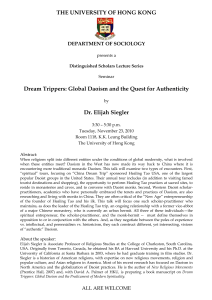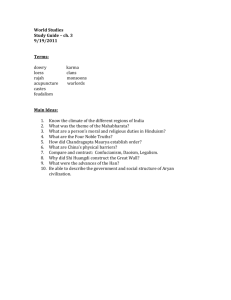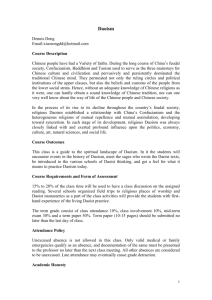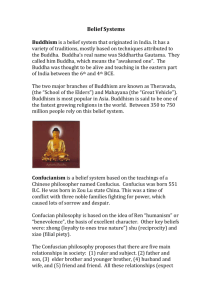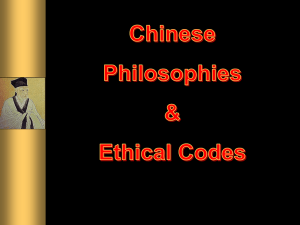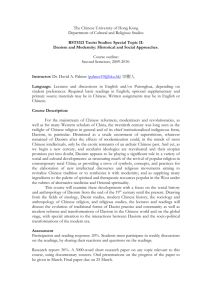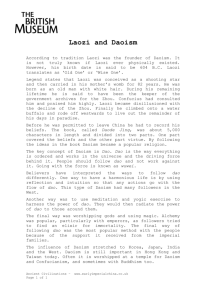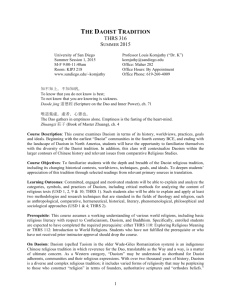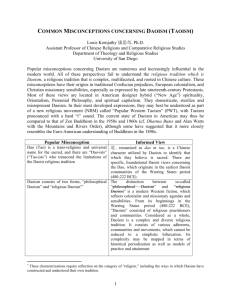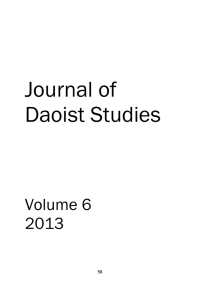Periodization of Daoist History
advertisement
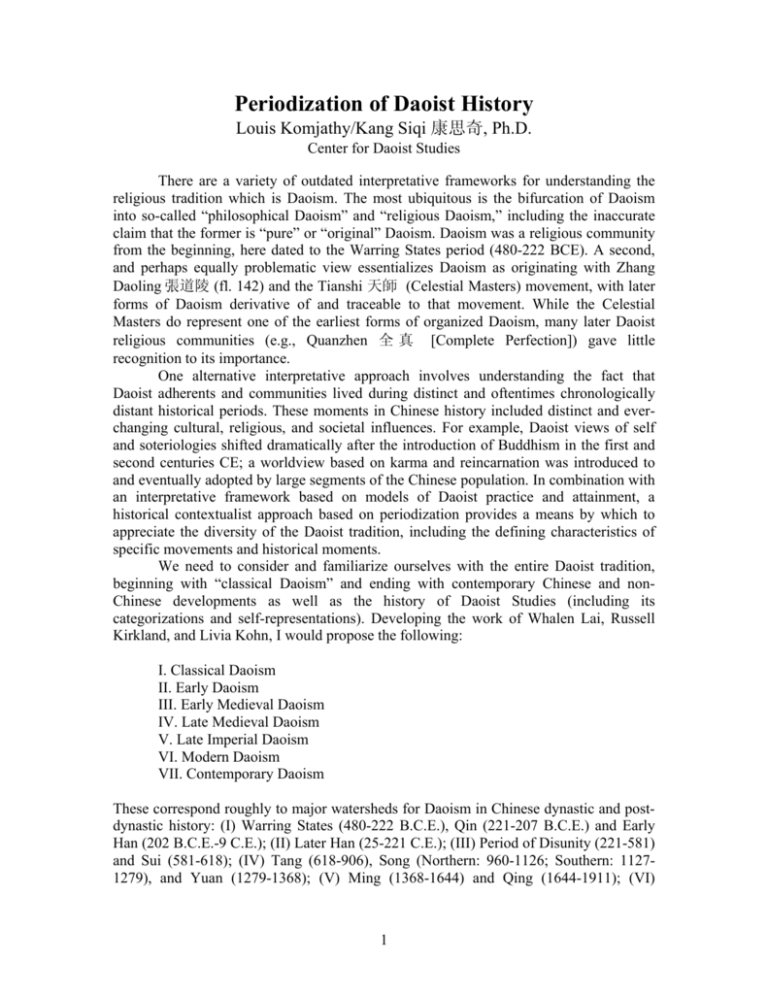
Periodization of Daoist History Louis Komjathy/Kang Siqi 康思奇, Ph.D. Center for Daoist Studies There are a variety of outdated interpretative frameworks for understanding the religious tradition which is Daoism. The most ubiquitous is the bifurcation of Daoism into so-called “philosophical Daoism” and “religious Daoism,” including the inaccurate claim that the former is “pure” or “original” Daoism. Daoism was a religious community from the beginning, here dated to the Warring States period (480-222 BCE). A second, and perhaps equally problematic view essentializes Daoism as originating with Zhang Daoling 張道陵 (fl. 142) and the Tianshi 天師 (Celestial Masters) movement, with later forms of Daoism derivative of and traceable to that movement. While the Celestial Masters do represent one of the earliest forms of organized Daoism, many later Daoist religious communities (e.g., Quanzhen 全 真 [Complete Perfection]) gave little recognition to its importance. One alternative interpretative approach involves understanding the fact that Daoist adherents and communities lived during distinct and oftentimes chronologically distant historical periods. These moments in Chinese history included distinct and everchanging cultural, religious, and societal influences. For example, Daoist views of self and soteriologies shifted dramatically after the introduction of Buddhism in the first and second centuries CE; a worldview based on karma and reincarnation was introduced to and eventually adopted by large segments of the Chinese population. In combination with an interpretative framework based on models of Daoist practice and attainment, a historical contextualist approach based on periodization provides a means by which to appreciate the diversity of the Daoist tradition, including the defining characteristics of specific movements and historical moments. We need to consider and familiarize ourselves with the entire Daoist tradition, beginning with “classical Daoism” and ending with contemporary Chinese and nonChinese developments as well as the history of Daoist Studies (including its categorizations and self-representations). Developing the work of Whalen Lai, Russell Kirkland, and Livia Kohn, I would propose the following: I. Classical Daoism II. Early Daoism III. Early Medieval Daoism IV. Late Medieval Daoism V. Late Imperial Daoism VI. Modern Daoism VII. Contemporary Daoism These correspond roughly to major watersheds for Daoism in Chinese dynastic and postdynastic history: (I) Warring States (480-222 B.C.E.), Qin (221-207 B.C.E.) and Early Han (202 B.C.E.-9 C.E.); (II) Later Han (25-221 C.E.); (III) Period of Disunity (221-581) and Sui (581-618); (IV) Tang (618-906), Song (Northern: 960-1126; Southern: 11271279), and Yuan (1279-1368); (V) Ming (1368-1644) and Qing (1644-1911); (VI) 1 Republican (1912-1949; 1949-) and Communist (1949-). Period VII encompasses more contemporary developments in mainland China, Hong Kong, and Taiwan. It also includes the transmission and transformation of Daoism in other Asian, European, and North American contexts, as well as the establishment of the field of Daoist Studies throughout the world. While helpful, such periods should not lull one into believing that they encompass the dramatic changes that occurred between, for instance, the Tang and Song periods. Classical Daoism includes the earliest Daoist adepts and communities, which Harold Roth of Brown University has referred to as the early “inner cultivation lineages.” The teachings, practices, goals, and ideals of these lineages are documented in specific texts of the Warring States, the most famous of which are the Laozi 老子(Book of Venerable Masters; a.k.a. Daode jing 道德經 [Scripture on the Dao and Inner Power]) and Zhuangzi 莊子(Book of Master Zhuang). However, recent revisionist scholarship includes parts of other important texts such as the Guanzi 管子 (Book of Master Guan), Huainanzi 淮南子 (Book of the Masters of Huainan), and Lüshi chunqiu 呂氏春秋 (Spring and Autumn Annals of Mister Lü). Drawing insights from these earlier practitioners and communities as well as Early Han dynasty (202 B.C.E.-9 C.E.) longevity practitioners, “formula masters” (fangshi 方士), and immortality seekers, early Daoism includes the Tianshi 天師 (Celestial Masters) and Taiping 太平(Great Peace) movements, which represent the beginning of the organized Daoist religious tradition. These movements branched out into the major schools of early medieval Daoism, namely, Taiqing 太清 (Great Clarity), Shangqing 上清 (Highest Clarity), and Lingbao 靈寶 (Numinous Treasure). The late medieval period includes the development of internal alchemy (neidan 內丹) lineages in the Tang (618-907) and Song (960-1279) dynasties and the emergence of the Quanzhen 全真 (Complete Perfection) monastic order. The Song and Yuan dynasties also witnessed the emergence of more popular forms of religiosity. In particular, deity cults and new ritual lineages became established, which were in turn incorporated into “orthodox” Daoist ritual. The late imperial period saw Zhengyi 正一 (Orthodox Unity), a Tang-dynasty reconstitution of Celestial Masters Daoism, and Quanzhen vying for religious supremacy. One also finds new lineages of internal alchemy during the Ming and Qing dynasties, which exemplified the late imperial tendency towards popularization, simplification, and syncretism. The formal establishment of the Longmen 龍門 (Dragon Gate) lineage of Quanzhen also occurred during the Qing dynasty (1644-1911). The modern period involves the breakdown of the Chinese imperial and dynastic system, including the loss of traditional patronage patterns and an increasing shift towards Western secularist ideologies. Following the Chinese Communist takeover in 1949 and the subsequent Cultural Revolution (1966-1976), Daoists and Daoist culture were disseminated throughout the modern world. Daoism became a global religious and cultural phenomenon practiced by people of diverse ethnic and cultural backgrounds. The contemporary period includes the revitalization of Daoism in mainland China, the emergence of a global Daoist religious community, as well as the ordination of non-Chinese Daoists and the establishment of tradition-based Daoist communities in Canada, Europe and North America. While overly simplistic, this basic outline provides some glimpses into the major movements and trends of each period of Daoist history. It should also be mentioned that most research to date has been done on the classical, early, and early medieval periods. I 2 will also add that in teaching Daoism to university students, I have found it helpful to discuss Daoism in terms of “classical Daoism” (classical period), “early organized Daoism” (early and early medieval periods), and “later organized Daoism” (late medieval to contemporary period). 3
